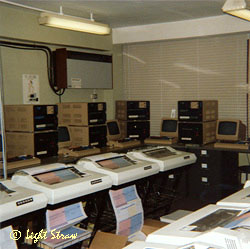|
Introduction
A Sales CO (Clerical Officer) would write out in manuscript, a hectograph AN master (pre-printed with a unique serial number). The AN master would then be spirit duplicated by the duplicating CA (Clerical Assistant) who would run off all the F packs, then the T, X and M packs to make up the correct number of copies for the pack type as already indicated by the issuing CO. Up until the 1980s, the AN master (at issue stage) was carbon copied onto an edge punched card to produce demand statistics for particular types of work.
Types & Pack Details
A full pack of ANs contained the following types of note:-
Blue, Yellow, Orange, Red, Green, Accounts White, Office White, Exchange White, Engineering Buff.
| Proforma Colour | |||||||||
| Pack Type | Blue | Yellow | Accounts White | Office White | Exchange White | Orange | Red | Green | Engineering Buff |
| Full | F | F | F | F | F | F | F | F | F |
| M | M | M | M | M | M | M | |||
| T | T | T | T | T | T | T | T | ||
| X | X | X | X | X | X | X | X | X | |
F type
Full pack, full circulation
M type
Internal work at customers premises
T type
Exchange work and office records
X type
Extra copy for stops where incoming tenant not known.
Closing
For installation work at the customer's premises, the buff and blue copies were returned to the office so that the job could be 'closed off' and billed. For exchange work only, the red and blue copies were needed to close the job.
To encourage speedy return of completed ANs, a slogan of the early Eighties was:
Red + Blue = Revenue
Computerisation
ANDES and ALPS
The Advice Note Data Entry System (ANDES) was a computerised version of an Advice Note for which the field trials were known as ALPS, the Area Local Pilot Scheme.
MOH
CSS
The Customer Service System ran from about 1985 on mainframes located at District Information Systems Units (DISUs).
All logos and trade marks are the property of their respective owners and are used on the Light Straw site(s) for review only. Students and researchers are recommended to make their own independent enquiries as to the accuracy of the information contained therein.
